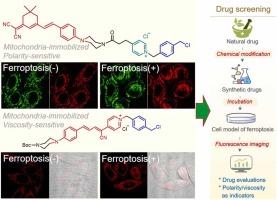线粒体固定化极性/黏度响应近红外(NIR)发射荧光探针用于铁中毒相关药物筛选的开发
IF 3.7
1区 化学
Q1 CHEMISTRY, ANALYTICAL
引用次数: 0
摘要
探索与铁中毒相关的新药物可以为以前无法治愈的疾病提供创造性的细胞保护途径和创新的治疗方法。在此,我们提出了一种利用线粒体固定化nir发射荧光探针(DCP和BCV)筛选铁质凋亡相关药物的策略。生物成像结果证实了DCP和BCV具有出色的线粒体固定化能力,并且erastin诱导的铁下垂明显增加了线粒体极性/粘度。槲皮素经酯化反应得到了具有较高logP分配系数的衍生物。以线粒体极性/黏度为指标,筛选乙酰化槲皮素作为抑制铁下垂的有效药物。通过光学实验和高效液相色谱分析,推测乙酰化槲皮素对铁中毒的抑制机制可能是基于槲皮素的铁(II)螯合作用和抗氧化活性的结合。总的来说,这项工作表明线粒体极性/粘度的荧光成像可以提供一种方便和切实的策略来筛选新的铁中毒相关药物。本文章由计算机程序翻译,如有差异,请以英文原文为准。

Development of mitochondria-immobilized polarity/viscosity-responsive near-infrared (NIR)-emissive fluorescent probes for the ferroptosis-associated drug screening
Exploration of new ferroptosis-associated drugs can provide creationary cytoprotective approaches and innovative therapeutic methods for the formerly incurable diseases. Herein, we present a strategy for the ferroptosis-associated drug screening by employing mitochondria-immobilized NIR-emissive fluorescent probes (DCP and BCV). Bioimaging results validated DCP and BCV possessed brilliant mitochondria-immobilized capacity, and erastin-induced ferroptosis observably increases mitochondrial polarity/viscosity. Quercetin was esterified to provide various derivatives with higher partition coefficients (logP). By using mitochondrial polarity/viscosity as indicators, the acetylated quercetin was screened as a potent drug to inhibit ferroptosis. Aided by optical tests and HPLC analysis, the inhibition mechanism of acetylated quercetin to ferroptosis was speculated to base on the integration of the Fe(II)-chelating effect and antioxidative activity of quercetin. Collectively, this work demonstrated that fluorescence imaging of mitochondrial polarity/viscosity can afford a convenient and tangible strategy to screen new ferroptosis-associated drugs.
求助全文
通过发布文献求助,成功后即可免费获取论文全文。
去求助
来源期刊

Sensors and Actuators B: Chemical
工程技术-电化学
CiteScore
14.60
自引率
11.90%
发文量
1776
审稿时长
3.2 months
期刊介绍:
Sensors & Actuators, B: Chemical is an international journal focused on the research and development of chemical transducers. It covers chemical sensors and biosensors, chemical actuators, and analytical microsystems. The journal is interdisciplinary, aiming to publish original works showcasing substantial advancements beyond the current state of the art in these fields, with practical applicability to solving meaningful analytical problems. Review articles are accepted by invitation from an Editor of the journal.
 求助内容:
求助内容: 应助结果提醒方式:
应助结果提醒方式:


